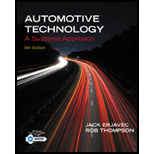
Automotive Technology: A Systems Approach (MindTap Course List)
6th Edition
ISBN: 9781133612315
Author: Jack Erjavec, Rob Thompson
Publisher: Cengage Learning
expand_more
expand_more
format_list_bulleted
Textbook Question
Chapter 31, Problem 1RQ
List four service precautions for working on the fuel injection system.
Expert Solution & Answer
To determine
Service precautions while working on the fuel injection system.
Explanation of Solution
The four service precautions for working on the fuel injection system are:
- To avoid the likelihood of flame and individual damage, dependably disengage the negative battery link except if the fix or test system necessitates that battery voltage be connected.
- Try not to permit fuel splash or fuel fumes to come into contact with a start or open fire.
- Continuously mitigate the fuel framework weight preceding disengaging any fuel framework segment. Exercise outrageous alert at whatever point mitigating fuel framework weight, to abstain from uncovering skin, face and eyes to fuel splash.
- Continuously keep a dry compound fire extinguisher close to the work region.
Want to see more full solutions like this?
Subscribe now to access step-by-step solutions to millions of textbook problems written by subject matter experts!
Students have asked these similar questions
25 mm
Brass core
E
=
105 GPa
0 = 20.9 x 10 °C
PROBLEM 2.49
The aluminum shell is fully bonded to the brass core and the
assembly is unstressed at a temperature of 15°C. Considering only
axial deformations, determine the stress in the aluminum when the
temperature reaches 195°C.
60 mm
Aluminum shell
E = 70 GPa
a = 23.6 × 10°C
This is an old practice exam. The answers are OAB = 19.10 ksi OBC = 2.228 ksi OCD = −2.865 ksi v = 0.2792delta Ltot = 0.01585 in (increase) but why
A random poly(styrene-butadiene) copoly-
mer has a number-average molecular weight of
350,000 g/mol and a degree of polymerization of
5000. Compute the fraction of styrene and buta-
diene repeat units in this copolymer.
H H
| |
-C-C-
방
H
Chapter 31 Solutions
Automotive Technology: A Systems Approach (MindTap Course List)
Ch. 31 - List four service precautions for working on the...Ch. 31 - What is indicated by a LTFT reading of 24 percent?Ch. 31 - What is the correct procedure for checking an...Ch. 31 - What is the difference between STFT and LTFT?Ch. 31 - The PCM checks for a closed throttle plate each...Ch. 31 - Which of the following is a likely cause of a lean...Ch. 31 - What problem may result from dirt buildup on an...Ch. 31 - Which of the following would not cause a...Ch. 31 - What is the correct way to test an injector with...Ch. 31 - What is the difference between the pulse width and...
Ch. 31 - How can you use a dual trace scope to make sure...Ch. 31 - What are three possible problems that can allow...Ch. 31 - What is the purpose of having two accelerator...Ch. 31 - What is indicated by a negative LTFT value?Ch. 31 - True or False? The signals from an air-fuel ratio...Ch. 31 - While discussing the causes of...Ch. 31 - While discussing IAC valve diagnosis: Technician A...Ch. 31 - While discussing IAC motor removal, service, and...Ch. 31 - While discussing injector testing: Technician A...Ch. 31 - While discussing airflow sensors: Technician A...Ch. 31 - While discussing scan tool diagnosis of fuel...Ch. 31 - While discussing a high idle speed problem:...Ch. 31 - While discussing the causes of a rich air-fuel...Ch. 31 - While diagnosing an idle speed problem: Technician...Ch. 31 - While looking at fuel trim values: Technician A...
Knowledge Booster
Learn more about
Need a deep-dive on the concept behind this application? Look no further. Learn more about this topic, mechanical-engineering and related others by exploring similar questions and additional content below.Similar questions
- Design and assemble on the fluidsim (or a draft) the Hydraulic Drive Circuit, with the following characteristics: (a) Sequential operation, pressure, for the advance and return of the cylinders (according to the proper operation for the device) controlled by a directional 4x3 way, closed center; (b) Speed control for the cylinders, according to the load signal; (c) Pressure counterbalance for cylinder A, in order to compensate for the weight of the assembly.arrow_forwardThis is an old exam practice question. The answer is Pmax = 218.8 kN normal stress governs but why?arrow_forwardMoist air initially at T₁ = 140°C, p₁ = 4 bar, and p₁ = 50% is contained in a 2.0-m³ closed, rigid tank. The tank contents are cooled to T₂ 35°C. Step 1 Determine the temperature at which condensation begins, in °C.arrow_forward
- Air at T₁ = 24°C, p₁ = 1 bar, 50% relative humidity enters an insulated chamber operating at steady state with a mass flow rate of 3 kg/min and mixes with a saturated moist air stream entering at T2=7°C, p₂ = 1 bar. A single mixed stream exits at T3-17°C, p3=1 bar. Neglect kinetic and potential energy effectsarrow_forwardHand calculation of cooling loadarrow_forwardAn HEV has a 24kW battery. How many miles can it go on electricity alone at 40 mph on a flat straight road with no headwind? Assume the rolling resistance factor is 0.018 and the Coefficient of Drag (aerodynamic) is 0.29 the frontal area is 2.25m^2 and the vehicle weighs 1618 kg.arrow_forward
- As shown in the figure below, moist air at T₁ = 36°C, 1 bar, and 35% relative humidity enters a heat exchanger operating at steady state with a volumetric flow rate of 10 m³/min and is cooled at constant pressure to 22°C. Ignoring kinetic and potential energy effects, determine: (a) the dew point temperature at the inlet, in °C. (b) the mass flow rate of moist air at the exit, in kg/min. (c) the relative humidity at the exit. (d) the rate of heat transfer from the moist air stream, in kW. (AV)1, T1 P₁ = 1 bar 11 = 35% 120 T₂=22°C P2 = 1 bararrow_forwardThe inside temperature of a wall in a dwelling is 19°C. If the air in the room is at 21°C, what is the maximum relative humidity, in percent, the air can have before condensation occurs on the wall?arrow_forwardThe inside temperature of a wall in a dwelling is 19°C. If the air in the room is at 21°C, what is the maximum relative humidity, in percent, the air can have before condensation occurs on the wall?arrow_forward
- ###arrow_forwardFind the closed loop transfer function and then plot the step response for diFerentvalues of K in MATLAB. Show step response plot for different values of K. Auto Controls Show solution for transform function and provide matlab code (use k(i) for for loop NO COPIED SOLUTIONSarrow_forwardThis is an old practice exam. The answer is Ta-a = 4.615 MPa max = 14.20 MPa Su = 31.24 MPa Sus = 10.15 MPa but why?arrow_forward
arrow_back_ios
SEE MORE QUESTIONS
arrow_forward_ios
Recommended textbooks for you
 Automotive Technology: A Systems Approach (MindTa...Mechanical EngineeringISBN:9781133612315Author:Jack Erjavec, Rob ThompsonPublisher:Cengage Learning
Automotive Technology: A Systems Approach (MindTa...Mechanical EngineeringISBN:9781133612315Author:Jack Erjavec, Rob ThompsonPublisher:Cengage Learning Automotive TechnologyMechanical EngineeringISBN:9781337794213Author:ERJAVEC, Jack.Publisher:Cengage,
Automotive TechnologyMechanical EngineeringISBN:9781337794213Author:ERJAVEC, Jack.Publisher:Cengage, Refrigeration and Air Conditioning Technology (Mi...Mechanical EngineeringISBN:9781305578296Author:John Tomczyk, Eugene Silberstein, Bill Whitman, Bill JohnsonPublisher:Cengage Learning
Refrigeration and Air Conditioning Technology (Mi...Mechanical EngineeringISBN:9781305578296Author:John Tomczyk, Eugene Silberstein, Bill Whitman, Bill JohnsonPublisher:Cengage Learning

Automotive Technology: A Systems Approach (MindTa...
Mechanical Engineering
ISBN:9781133612315
Author:Jack Erjavec, Rob Thompson
Publisher:Cengage Learning

Automotive Technology
Mechanical Engineering
ISBN:9781337794213
Author:ERJAVEC, Jack.
Publisher:Cengage,

Refrigeration and Air Conditioning Technology (Mi...
Mechanical Engineering
ISBN:9781305578296
Author:John Tomczyk, Eugene Silberstein, Bill Whitman, Bill Johnson
Publisher:Cengage Learning
The Refrigeration Cycle Explained - The Four Major Components; Author: HVAC Know It All;https://www.youtube.com/watch?v=zfciSvOZDUY;License: Standard YouTube License, CC-BY